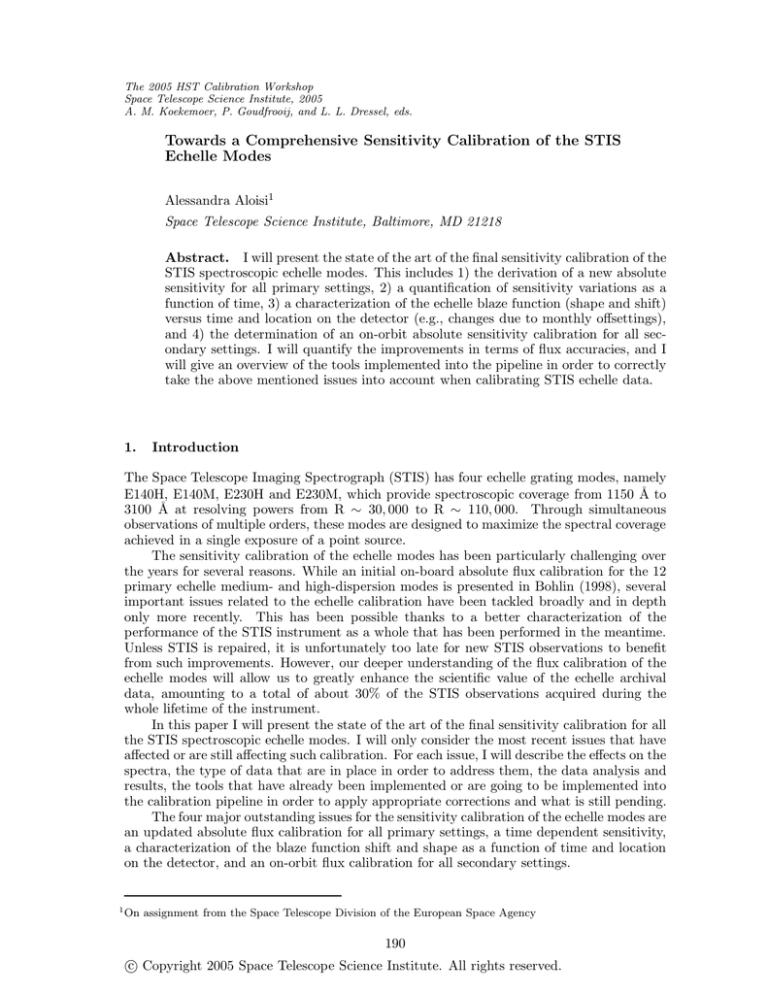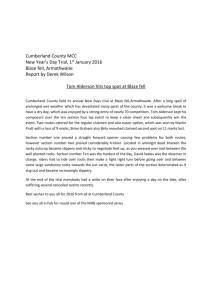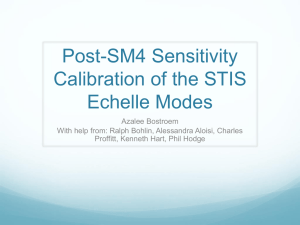
The 2005 HST Calibration Workshop
Space Telescope Science Institute, 2005
A. M. Koekemoer, P. Goudfrooij, and L. L. Dressel, eds.
Towards a Comprehensive Sensitivity Calibration of the STIS
Echelle Modes
Alessandra Aloisi1
Space Telescope Science Institute, Baltimore, MD 21218
Abstract. I will present the state of the art of the final sensitivity calibration of the
STIS spectroscopic echelle modes. This includes 1) the derivation of a new absolute
sensitivity for all primary settings, 2) a quantification of sensitivity variations as a
function of time, 3) a characterization of the echelle blaze function (shape and shift)
versus time and location on the detector (e.g., changes due to monthly offsettings),
and 4) the determination of an on-orbit absolute sensitivity calibration for all secondary settings. I will quantify the improvements in terms of flux accuracies, and I
will give an overview of the tools implemented into the pipeline in order to correctly
take the above mentioned issues into account when calibrating STIS echelle data.
1.
Introduction
The Space Telescope Imaging Spectrograph (STIS) has four echelle grating modes, namely
E140H, E140M, E230H and E230M, which provide spectroscopic coverage from 1150 Å to
3100 Å at resolving powers from R ∼ 30, 000 to R ∼ 110, 000. Through simultaneous
observations of multiple orders, these modes are designed to maximize the spectral coverage
achieved in a single exposure of a point source.
The sensitivity calibration of the echelle modes has been particularly challenging over
the years for several reasons. While an initial on-board absolute flux calibration for the 12
primary echelle medium- and high-dispersion modes is presented in Bohlin (1998), several
important issues related to the echelle calibration have been tackled broadly and in depth
only more recently. This has been possible thanks to a better characterization of the
performance of the STIS instrument as a whole that has been performed in the meantime.
Unless STIS is repaired, it is unfortunately too late for new STIS observations to benefit
from such improvements. However, our deeper understanding of the flux calibration of the
echelle modes will allow us to greatly enhance the scientific value of the echelle archival
data, amounting to a total of about 30% of the STIS observations acquired during the
whole lifetime of the instrument.
In this paper I will present the state of the art of the final sensitivity calibration for all
the STIS spectroscopic echelle modes. I will only consider the most recent issues that have
affected or are still affecting such calibration. For each issue, I will describe the effects on the
spectra, the type of data that are in place in order to address them, the data analysis and
results, the tools that have already been implemented or are going to be implemented into
the calibration pipeline in order to apply appropriate corrections and what is still pending.
The four major outstanding issues for the sensitivity calibration of the echelle modes are
an updated absolute flux calibration for all primary settings, a time dependent sensitivity,
a characterization of the blaze function shift and shape as a function of time and location
on the detector, and an on-orbit flux calibration for all secondary settings.
1
On assignment from the Space Telescope Division of the European Space Agency
190
c Copyright 2005 Space Telescope Science Institute. All rights reserved.
Towards a Comprehensive Sensitivity Calibration of the STIS Echelle Modes
2.
191
Updated Absolute Sensitivity Calibration for Primary Settings
The absolute sensitivity calibration of the STIS echelle spectroscopic modes is derived with
an empirical method consisting in dividing the observed count rates by the known flux
of a standard star. For all the echelle primary settings, this calibration is based upon
observations of the pure hydrogen white dwarf G 191-B2B (STIS primary standard star),
and the hot-subdwarfs BD +75◦ 325 and BD +28◦ 4211 (STIS secondary standard stars) and
is detailed in Bohlin (1998). The observations were obtained by programs 7096, 7657, 7673,
and 7917 during 1997 and 1998. The 0.2X0.2 aperture and the standard peak-up target
acquisition were used for this purpose.
We have recently re-derived the sensitivity calibration of the echelle primary settings
in light of the implementation of an improved algorithm for the subtraction of the scattered
light. This new algorithm, developed by Lindler & Bowers (2001), turned out to be necessary
in order to avoid unrealistic negative fluxes in the saturated cores of strong absorption lines,
and was installed in the archive pipeline on December 21, 2000 with CALSTIS version 2.9
(Valenti et al. 2002). It is based on a two-dimensional scattered light model of the telescope
and spectrograph, instead of being a simple one-dimensional linear interpolation of the
minimum intensity between echelle orders. Its application reduces the corresponding flux
uncertainties from about 10% to less than 2% (see Figure. 1 in Valenti et al. 2002).
Following the introduction of this 2D algorithm, the sensitivity calibration was redetermined in a self-consistent way. The new calibration differs by 2-7%, depending on the
primary setting considered, compared to the calibration previously available. The changes,
as expected, are not due to the improved scattered light subtraction, since heavily absorbed
lines are not included in the sensitivity determination process. They are instead due to 1) an
updated procedure that filters sharp absorption lines in the echelle spectra of the observed
standard stars during the order-by-order sensitivity determination (see Bohlin 1998 for more
details), 2) the removal of observations with non-zero monthly offsetting in order to avoid
flux uncertainties related to the resulting shift of the blaze function, and 3) the inclusion
of additional observations from the monitoring program 7673 spanning a longer time frame
(up to middle 1999).
New PHOTTAB reference files were delivered to the pipeline on April 4, 2005. The
time dependence of the sensitivity (see § 3) and the shift of the blaze function (see § 4)
and were also backed out for self consistency. The new files reduce the flux uncertainty on
the absolute flux calibration to less than a few %. Figure 1 shows the improvement in the
flux calibration for observations of the standard star BD +28◦ 4211 taken in 1997.7 with the
grating E140M centered at 1425 Å.
3.
Time-Dependent Sensitivity
A few representative primary settings of the four STIS echelle gratings were routinely monitored over the operational lifetime of the instrument in order to follow time dependent
changes in sensitivity due to contaminants or other causes. The relatively bright (V = 10.52
mag) spectrophotometric standard star BD +28◦ 4211 was used for this purpose with a
0.2X0.2 aperture. The observations were obtained twice a year as part of the Sensitivity Monitor calibration programs 7673, 8424, 8857, 8919, 9628, and 10033. The normal
mode select mechanism (MSM) shifting was disabled for these monitoring observations in
order to minimize variations due to spatial displacements of the spectra (see § 4). The
echelle settings monitored in this way include E140H(1416), E140M(1425), E230H(2263),
and E230M(1978, 2707).
The analysis of the monitoring observations for the low-dispersion modes already established clear evidence for wavelength dependent variations of the UV throughput over
time (Stys, Bohlin, & Goudfrooij 2004 and references therein) at rates at times as high as
192
Aloisi
3% and 1-2% per year in the FUV and NUV, respectively. A comparison of the spectra of
the same standard star taken at different epochs in the same setting indicates that a similar
phenomenon affects echelle observations. Flux uncertainties as high as ∼ 15-20% are observed in the most recent datasets. Figure 2 shows an example of the flux of the standard
star BD +28◦ 4211 observed at different epochs in the E140M(1425) primary setting.
An analysis of the echelle monitoring data indicates that the primary settings investigated so far have a time-dependent sensitivity (TDS) which is similar to that observed
for the first order modes (i.e., Figures. 6 and 7 in Stys et al. 2004). An example of these
sensitivity changes over time is given in Fig. 3. A larger scatter, however, is observed in the
echelle data compared to the first-order modes. We are still in the process of investigating
the cause of such a scatter. This could be due, e.g., to 1) temperature effects in the FUV,
as already observed in the first-order modes, 2) miscentering of the source in the smaller
aperture used (0.2X0.2 versus the 52X2 slit of the first-order modes), or 3) a not properly
corrected time dependence of the blaze shift (see § 4).
Since the monitored echelle primary settings behave similarly to the corresponding
first-order modes in terms of TDS and a much larger number of observations is available
for the latter to properly characterize the sensitivity change with time, we adopted the
first-order mode correction for all the echelle settings. New TDSTAB reference files were
delivered to the pipeline on April 4, 2005 in order to take this correction into account. In
light of this delivery, the uncertainty associated to the absolute sensitivity of the echelle
primary modes is reduced from about 15-20% to less than a few %, as shown in Fig. 4 for
E140M(1425).
4.
Blaze Function Calibration Issues
In echelle spectroscopic mode the spectrum of a target is broken up into several orders arranged as quasi-horizontal stripes on a two-dimensional detector (e.g., MAMA detectors).
The characteristic efficiency along a single order is known as echelle blaze function or echelle
ripple, because of its characteristic shape. Each spectral order needs to be corrected for
the echelle blaze function before merging all the orders together to form a single calibrated
spectrum. As already mentioned in § 2, this correction is performed by following an empirical approach in the case of STIS. Early observations of spectrophotometric standard stars
are used to determine both the average sensitivity and the shape of the blaze function of
each order by fitting a set of spline nodes to the ratio of the observed count rate divided by
the standard star flux. However, there are additional complications for STIS. The echelle
blaze function varies with location of the spectrum on the detector and with time since
the instrument was installed on HST (e.g., due to contaminants or changes in the optics).
These changes lead to saw-tooth wavelength dependent flux calibration errors that can be
as large as about 15-20%. Figure 2 shows an example of how the scallopping of the spectra
of the same standard star worsens with time due to blaze function variations not properly
handled by the calibration pipeline.
Two types of changes can affect the blaze function, namely shifts and shape variations.
Also, it is necessary to distinguish between effects due to location and effects due to time.
This is the reason why a modular approach was selected where the spatial and temporal
variations of the blaze function were tackled separately. Two different datasets were used
for this purpose. A set of observations with the same zero monthly offsetting but different
observational epochs was used to address temporal variations. A complementary set of
observations taken in the same epoch with different monthly offsettings was instead analysed
to determine spatial dependencies of the blaze function.
Towards a Comprehensive Sensitivity Calibration of the STIS Echelle Modes
193
Figure 1: Flux of the standard star BD +28◦ 4211 observed with HST/STIS in 1997.7 in
the echelle primary setting E140M(1425) and calibrated with the old (green) and the new
(red) PHOTTAB reference file. HST/FOS observations are also indicated (black). The new
sensitivity calibration differs by about 6% and 3% at around 1250 and 1650 Å, respectively.
Figure 2: Flux of the standard star BD +28◦ 4211 observed in the E140M(1425) echelle
primary setting in 1997.7 (black), 2000.9 (green), and 2004.0 (red). The latest observations
have a flux calibration which is about 4% and 15% lower at around 1250 and 1650 Å,
respectively, than the observations acquired at the beginning of STIS operations. The
scallopping of the spectra that worsens with time is due to an extrapolation within the
pipeline of the blaze shift correction that does not properly handle datasets acquired after
2001 (see § 4 for more details).
194
Aloisi
Figure 3: Sensitivity changes with time in selected orders of the E140M(1425) echelle primary mode covering the 1501 to 1565 Å wavelength interval (red asterisks). TDS-corrected
sensitivities are also shown (black asterisks). The correction is performed by considering
the piece-wise linear fit to the TDS of the low-resolution G140L grating (solid line).
Figure 4: Flux of the standard star BD +28◦ 4211 in the E140M(1425) echelle primary
setting as observed in 2004 with (red) and without (green) TDS correction. The similarity
of the echelle corrected flux compared to the HST/FOS flux (black) is remarkable. We are
still in the process of properly correcting the scallopping of the spectra due to blaze shift
effects.
Towards a Comprehensive Sensitivity Calibration of the STIS Echelle Modes
4.1.
195
Blaze Shift Corrections already implemented into the Pipeline
Bowers & Lindler (2003) already demonstrated with simple optics concepts that the blaze
function shifts by a certain number of pixels when a spectrum is acquired with an offset of
the STIS MSM that makes it fall onto a slightly different position on the MAMA detectors.
In the past, monthly offsettings were used regularly for STIS observations in order to uniformly age the MAMA detectors. Also, the blaze function shifts by a different number of
pixels compared to the position of the spectrum itself, i.e., compared to the wavelength scale.
An algorithm was also developed by Bowers & Lindler in order to predict a simple linear
offset of the nominal calibration curve for each MSM shift. All archival non-proprietary
echelle observations of sources with a continuum over the period from STIS launch to
December 2001 were used for this purpose. The blaze shift of each dataset was inferred
by shifting the echelle ripple pattern until the overlapping regions of adjacent orders are
coincident. The shift was then correlated to the spectral shifts in both dispersion (∆x)
and cross-dispersion direction (∆y) as determined from the accompanying spectral wave
calibration exposures (wavecal). However, the 2-parameter linear model suggested by optics
considerations and initially adopted by Bowers & Lindler, showed time-correlated residuals
with an amplitude much larger than expected by simple TDS effects. As a consequence, a
linear variation with time was also inserted in the algorithm and attributed to small changes
in the grating itself.
The grating-dependent Bowers & Lindler’s algorithm was implemented into the pipeline
on September 5, 2002 with CALSTIS version 2.13b, and corrects all primary settings for
the blaze shift. In addition, the monthly offsetting was turned off for echelle spectral modes
starting in August 2002 in order to avoid the related flux uncertainties. While only earlier
spectra are affected by the spatial component of the blaze shift, the temporal component
has clearly continued to be present in all the echelle observations taken until the STIS failure
in August 2004.
4.2.
Temporal Variations of the Blaze Function
The time dependence of the blaze shift already implemented into the pipeline has been
recently checked in order to verify that its extrapolation properly corrects echelle data
acquired after 2001. The same monitoring observations of the standard star BD +28◦ 4211
used to characterize TDS in five selected echelle primary modes (see § 3), were considered
within this context. As previously mentioned, such observations were acquired with zero
monthly offsetting over the whole period of STIS operations from 1997 to 2004.
For each setting and order, the blaze function was fitted with a third- or forth-order
polynomial and a sigma-clipping algorithm to reject absorption lines, since the wavelength
scale shifts differently compared to the blaze function. The fit was then normalized to its
maximum in order to eliminate TDS and/or miscentering effects. Finally, the blaze shift of
each order was obtained by cross-correlating the normalized fit of the blaze function at a
certain epoch to the normalized fit of the blaze function in the first epoch available for each
setting. The major result of this study is that the extrapolation of the time dependence of
the blaze shift implemented into the pipeline does not hold anymore for reasons that differ
from one grating to the other. The procedure we followed also allowed us to verify that the
blaze function shape does not change with time within the flux uncertainties (< 5%) of the
standard star used.
In particular, an order dependence of the blaze shift was discovered for the first time.
This dependence is mainly linear, even if second-order non-linear effects cannot be excluded,
especially in the case of the E140H(1416) and E140M(1425) primary settings. Also, a
different behavior of the blaze shift with time and order is observed depending on the grating
considered. For E140H(1416), E140M(1425), and E230H(2263), the order dependence of the
blaze shift gets stronger with time, with differences up to approximately 50 pixels between
extreme orders in the worst case of the latest E140M(1425) dataset. An example of such a
196
Aloisi
trend is shown in Fig. 5 for the E230H(2263) primary setting. Since the Bowers & Lindler’s
algorithm is order independent, it gives a single blaze shift value which is an average over
the orders and does not properly correct the extreme orders. Differences up to about 25
pixels between the pipeline value and the most appropriate blaze shift of such orders can
be observed in the most recent observations. On the other hand, the order dependence of
E230M at the central wavelengths 1978 and 2707 Å remains practically constant with time.
While E140H(1416), E140M(1425), and E230H(2263) have a blaze shift averaged over
the orders that increases or decreases linearly with time, E230M centered at the two central
wavelengths 1978 and 2707 Å, has an average blaze shift that clearly reverses its trend
after the switch to Side 2 STIS operations in July 2001. This implies that the linear
extrapolation of the Bowers & Lindler’s algorithm is not suitable for data taken after that
date. Errors as high as about 10 pixels are associated with such extrapolation. It is also
interesting to notice that the two different primary settings of E230M have the same blaze
shift behavior with time and order. This is an additional indication that the change with
time is related to some physical parameter within the grating itself and not to wavelength
dependent variations within the detector.
The implementation into the pipeline of a blaze shift time dependence that is also order
dependent is still pending. New PHOTTAB reference file will be delivered in order to take
such corrections into account. Once implemented, the new blaze shift correction will reduce
the wavelength-dependent flux uncertainties to less than a few %. Figure 6 gives an idea of
the type of improvements expected with this update.
4.3.
Spatial Variations of the Blaze Function
The blaze function behavior versus the location on the detector was also investigated by
using a homogeneous set of data from the calibration program 9619. The observations were
simultaneously obtained with a 0.2X0.2 aperture and five different monthly offsettings in
July 2002. Only the E230H(2513) primary setting was considered for this purpose. The
data were analyzed with a procedure similar to the one used for the characterization of the
temporal dependence of the blaze function. Once again, there is no indication of a change
in the blaze function shape with position of the spectrum on the detector. Also, no strong
dependence of the blaze shift on the order was found. Furthermore, the blaze shift averaged
over the orders for a certain monthly offsetting, is similar to the value obtained with the
Bowers and Lindler’s algorithm of the pipeline, once the zero monthly offsetting is taken
as reference, i.e., once the time component of the blaze shift is eliminated. This indicates
that the blaze shift dependence on the detector location is already well characterized by the
pipeline algorithm, at least for the E230H grating. The verification of the spatial component
of the blaze shift adopted into the pipeline for the other gratings is still under review.
5.
Calibration of the Secondary Settings
The last issue still pending for the sensitivity calibration of the STIS echelle modes is an
improved calibration of the secondary settings. These settings are used almost as often
as the primary settings. However, their absolute sensitivity calibration is still based on
pre-launch data. Moreover, while TDS corrections have already been implemented into the
pipeline for these settings based on the first-order mode trends, no attempt has been made
so far to correct for blaze shifts. The similar behavior observed for the two different primary
settings of E230M, seems to indicate that the blaze shift correction is in fact independent
of the central wavelength, but we are still in the process of verifying this for the secondary
settings.
On-board data of the primary spectrophotometric standard star G191-B2B within a
0.2X0.2 aperture were obtained for all primary and secondary settings in September 2001 as
part of the calibration program 8915. The primary modes of such a homogeneous dataset
Towards a Comprehensive Sensitivity Calibration of the STIS Echelle Modes
197
Figure 5: Blaze shift in pixels as a function of the order for every dataset analyzed in the
E230H(2263) primary setting. The corresponding linear fit is also plotted for reference. See
text for more details on how the shifts were derived. Different colors indicate datasets at
different epochs. Blaze shift values associated to each dataset by the calibration pipeline
are also indicated (black asterisks).
Figure 6: Flux of the standard star BD +28◦ 4211 in the wavelength range 2050-2200 Å as
observed in 2004.4 in the E230M(1978) primary setting with pipeline (green) and appropriate (red) correction of the blaze shift. The flux observed with HST/FOS is also indicated
(black).
198
Aloisi
will be used to anchor all sorts of corrections of the secondary settings to the trends observed
for the primary settings. The analysis of this dataset is still pending, but once completed
it will give an on-board flux calibration for all echelle secondary settings that will reduce
the associated errors from about 15% to 3-5%.
References
Bohlin, R. C. 1998, Instrument Science Report STIS 98-18 (Baltimore: STScI)
Bowers, C., & Lindler, D. 2003, in Proc. 2002 HST Calibration Workshop, ed. S. Arribas,
A. Koekemoer, & B. Whitmore (Baltimore: STScI), p. 127
Lindler, D., & Bowers, C. 2001, BAAS, 197.1202
Stys, D. J., Bohlin, R. C., & Goudfrooij, P. 2004, Instrument Science Report STIS 2004-04
(Baltimore: STScI), available through http://www.stsci.edu/hst/stis
Valenti, J.A., Lindler, D., Bowers, C., Busko, I., & Kim Quijano, J. 2002, Instrument
Science Report STIS 2002-001 (Baltimore: STScI)






